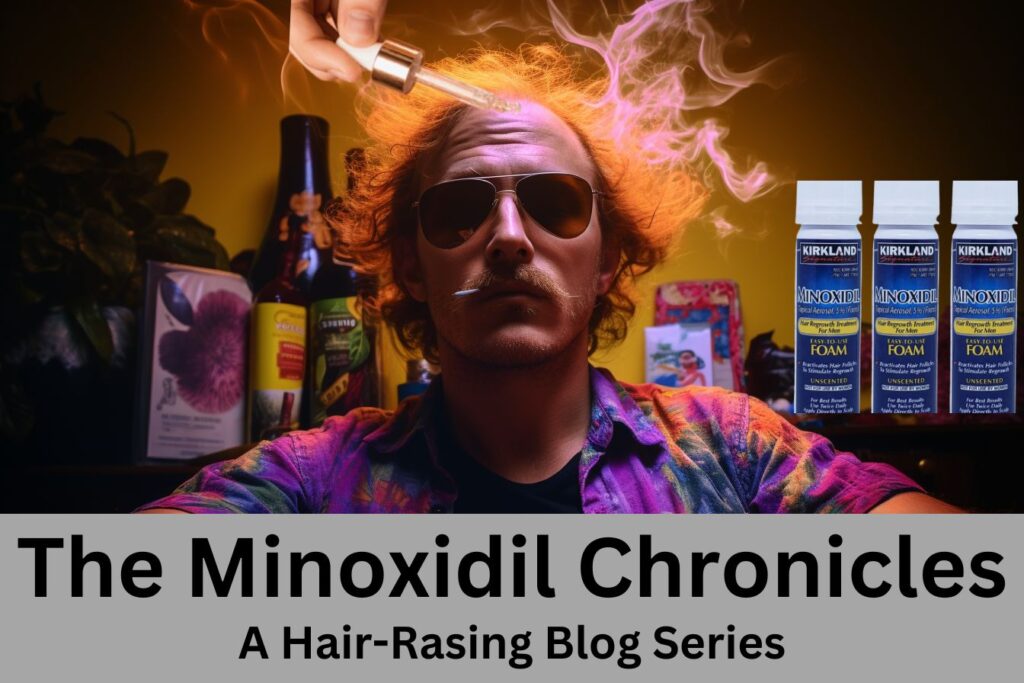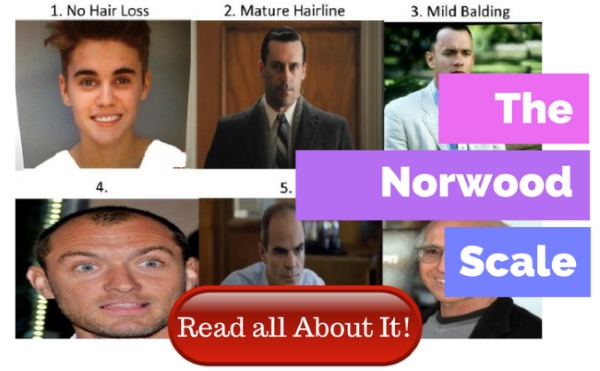Last Updated on August 11, 2023 by Robert Price
Rogaine is a proven hair loss treatment option that can dramatically slow the balding process.
That’s been established.
But the jury’s still out on which version of Rogaine/minoxidil is better, the liquid or the foam. And in this post, I’m going to be the judge and jury.
Do you have a problem with that? I’m a hair loss researcher, blogger, and consumer advocate with thousands of hours of experience at this point, so I hope not. Also, five years after starting this site, I realized I was going bald in 2021. And guess which treatment I chose to help me win my battle against hair loss? Minoxidil, of course!
Over the last year and a half, I’ve used both over-the-counter versions of the medication for extended periods of time, and I’ll detail some of my personal experiences for you. In my post, I’ll also incorporate commentary from hair loss experts and product reviews from everyday minoxidil users as I compare foam vs. liquid minoxidil based on the following six metrics.
- Price
- Convenience
- Ease of Use
- Side Effects
- Aesthetics/Utility
- Effectiveness
By the end of this article, you should be able to determine which version of minoxidil best suits your needs and lifestyle.
Note – this article contains affiliate links, meaning I may earn a small commission (at no extra cost to you) if you purchase a product via a link on this site/page. Learn more here.
Let’s begin.
Comparing Minoxidil Liquid vs. Foam Based on Six Critical Factors
1. Price
Winner: Standard Liquid Minoxidil
The liquid minoxidil is generally cheaper than the foam, especially if you purchase one of the popular generic forms of the product, such as the Kirkland-brand minoxidil.
On Amazon, you can currently pick up a 6-month supply of Amazon-brand minoxidil for around $30. Pricing will vary, of course. The foam isn’t particularly expensive either, but it’s usually a few dollars more per bottle, starting at around $9 a bottle for the Kirkland brand.
I’ve also heard many people complain about needing to use more of the foam in order to get full coverage on their scalps, which increases their overall cost per bottle. In my experience, I didn’t feel as though I needed to apply extra product to my thinning area when I used the foam, but my hair loss is relatively mild and isolated at my crown. If you’re suffering from a more advanced variety of hair loss, the liquid may yield a little more coverage and therefore be a more economical option for you.
2. Ease of Use
Winner – Minoxidil Foam
It takes a little longer to fill a dropper with liquid minoxidil than it does to dispense a half capful of foam minoxidil (I’ll have some more application tips for you later in the article). Granted, you probably won’t save more than a few seconds per treatment if you choose the foam over the liquid, but you only get 8,640 seconds per day, and if you literally want to make all of those seconds count, the foam will be the better option for you.
Also, you’re probably less likely to have a “mishap” while using the foam version of the product. Personally, I’ve had liquid minoxidil drip onto my forehead and face on many occasions, flow onto areas of my scalp where I didn’t want it to go, and even gotten the product in my eye once or twice (I may or may not have been intoxicated at the time). The foam is less messy and accordingly a little easier to use for most people.
3. Convenience
Winner – Minoxidil Foam
Minoxidil foam dries faster than liquid minoxidil. It’s also easier to apply, as I noted in section two of this post.
So if you’re looking for a minoxidil product that’s super easy to fit into your daily routine, the foam is probably your best bet. The Rogaine website compares applying the foam to brushing your teeth, which is not a bad analogy or complete marketing BS. There’s a semblance of truth to it!
I find that the foam is actually a decent standalone hairstyling product, which is another reason I believe it’s more convenient to use than the liquid. The liquid won’t necessarily make styling your hair harder, but it probably won’t make the process easier either.
The Long Hair Exception
If you still have a lot of hair, or longer hair, you may find it difficult to reach your problem areas while using minoxidil foam. And if that’s the case, the liquid may be a better option for you.
4. Aesthetics/Utility
Winner – Minoxidil Foam
“It’s too greasy” is a common gripe among liquid minoxidil users. I don’t have that particular complaint about the product. Sure, it’s greasier than the foam, and I definitely feel as though I need to wash my hands thoroughly after applying the liquid (I wash them after using the foam too, of course, but with less vigor).
Some people recommend liquid minoxidil as a styling product as well! It comes down to preference, but ultimately, I think it’s safe to say that the majority of minoxidil users prefer the foam to the liquid when it comes to aesthetics and hair styling.
5. Side Effects
Winner – Minoxidil Foam
Glycol, which acts as a delivery agent for liquid minoxidil, is known to cause a variety of skin issues, from redness to contact dermatitis. Minoxidil/Rogaine foam is known for causing fewer side effects overall, and thus is the winner here. It should be noted, however, that both the liquid and foam medications are well tolerated and that only a small percentage of users report dermatological side effects with liquid minoxidil. Over the last year and a half, I haven’t experienced any side effects with either variety of the medication.
6. Effectiveness
Winner – Liquid Minoxidil, by one single hair on your balding head!
Most of the other points were indisputable in this comparison. The effectiveness of minoxidil foam vs. liquid, however, is something that even many hair loss experts disagree on. Robert Bernstein and William Rassman, co-authors of the book Hair Loss and Restoration for Dummies, fall on opposite ends of the debate, with Rassman preferring the foam and Bernstein recommending the liquid (1, 2).
Bernstein’s argument is more compelling, though, in my opinion. He notes that gycol is a better delivery agent, and that the foam has a tendency to get “caught up” in people’s hair.
A 2011 article in the Indian Journal of Dermatology also suggested that liquid minoxidil may be more effective in terms of hair regrowth.
Breaking it Down, Point By Point
Just to refresh your memory, here are the winners in each category.
- Affordability – Minoxidil liquid
- Ease of Use – Minoxidil foam
- Convenience – Foam
- Aesthetics – Foam
- Side Effects – Foam
- Effectiveness – Liquid, but just barely!
Now, drum roll please.
The Winner Is…
Minoxidil Foam, with One Big Caveat!
The liquid might actually work better! Based on everything I’ve read, the liquid does actually penetrate the scalp more efficiently than the foam, delivering the medication to where it’s needed. Is there a huge difference in terms of effectiveness between the two products? I doubt it. And because the foam is more convenient to use, compliance rates may be slightly higher with that version of the product.
I actually prefer the liquid overall, mainly because it’s cheaper and easy enough to apply for me, but I often keep a bottle of the foam on hand because it’s a far better styling product, in my opinion.
Related Content

In the minoxidil chronicles, I talk about my experiences using the product–the good, bad, and ugly.
It Comes Down to Preference
There’s no reason you can’t try both the liquid and foam to see which one you like better! Buy a bottle of each and conduct your own little experiment.
Ultimately, choosing which minoxidil you use is analogous to choosing your preferred cola. Okay, maybe that’s a bad analogy because everyone prefers Coke over Pepsi.
It’s more akin to choosing your favorite light beer. They all suck. No one with any taste enjoys drinking light beer, but it gets the job done — and Coors Light is slightly less repugnant than the other two in my view and is therefore the best option.
Similarly, no one relishes applying minoxidil everyday, in foam or liquid form. But trying both could be a wise move on your part, just so you can figure out which version of the product you’ll despise the least. Assuming it works, which hopefully it does, you could be using minoxidil for many years to come!
Once or Twice Per Day?
For men, the standard dose is one ml (or approx. 1/2 capful of the foam) twice daily.
However, many doctors, including Dr. Bernstein of Bernstein Medical, advise their patients that using minoxidil once daily is sufficient.
Bernstein states that compliance can be an issue for patients with minoxidil. Accordingly, he says that using the product once per day is enough to yield positive results, provided the patient administers double the recommended dose.
Minoxidil has a half-life of about 22 hours. So if you use twice as much product once per day, it should work just about as well as the standard twice-daily regimen.
Women are more sensitive to minoxidil’s effects than men. They can either use the 5% formula once per day, or the 2% minoxidil twice per day.
Seven Quick Tips for Applying Minoxidil
- Read the instructions. That’s obvious I know, but it’s a step many people skip and one of the 8 most common minoxidil mistakes.
- Use on dry hair only. You don’t need to shampoo ahead of time.
- Make sure the product gets into your scalp. You need to massage it in and make sure the product reaches your follicles.
- Make several parts in your hair if you can prior to application. This will help you see the areas that are thinning and ensure even distribution of the medication.
- Hit the “Problem” Areas – Of course, you should cover every area that’s thinning or receding.
- Treat the Crown Too, Even if You’re Not Thinning Back There Yet – Chances are you’ll start losing it on your crown eventually. So you might as well treat the problem preemptively.
- Wash Your Hands Afterwards.
Three Minoxidil Alternatives
If you’re not quite sold on minoxidil liquid or foam at this point, here are few alternative hair loss treatments for your consideration:
1. Finasteride – finasteride is sort of the male equivalent to “the pill.” Like the female version of “the pill” — i.e. birth control — finasteride comes with an array of unpleasant, potential side effects, primarily of the sexual variety. The drug has an excellent safety profile overall and has been FDA-approved to treat hair loss for over 25 years.
Women have begun using finasteride “off label” too, but it’s not typically a first-line treatment option for women. Finasteride works considerably better than minoxidil overall and can halt hair loss dead in its tracks in roughly 90% of users.
2. Laser Therapy – As I’ve said before, laser therapy is the “embarrassing” hair loss remedy. It works to some degree, but you’d probably be mortified if your girlfriend or beer buddies “caught” you wearing a ridiculous-looking laser helmet or cap.
As of now, laser therapy is more of a supplementary treatment for men that I don’t typically recommend to anyone who isn’t 100% committed to fighting hair loss on a long-term basis. On the other hand, laser therapy is widely used as a somewhat effective, primary treatment for female hair loss.
Overall, it’s a treatment that can help you maintain what you have and maybe regrow a few hairs too, but laser therapy is unlikely to produce to any miraculous gains for you.

To find out if laser therapy is a legit treatment option for hair loss, check out my article describing the 7 things you should know before you buy a laser device (or simply click on the above picture).
3. The “Natural” Route – A number of natural remedies show some promise in treating minoxidil, including rosemary oil, pumpkin seed oil, and saw palmetto to name a few. Will any of these natural solutions work as well as minoxidil? No, I imagine that’s very unlikely, but they may help treat hair loss to a limited extent.
Top-Rated Minoxidil Products and Closing Thoughts
- Rogaine Foam – After over 30 years, Rogaine’s still the #1 minoxidil brand. As of 2023, it’s literally helped multiple generations of men avoid premature baldness.
- Kirkland Liquid Minoxidil – A popular, budget-friendly option. Kirkland is a trusted brand that offers a quality product at an affordable price.
- Rogaine Foam for Women – The 5%, once-daily solution. The product has been shown to work for about 60% of women.
Have you personally used minoxidil foam, liquid, or both? Which version do you think is better and why?
Good luck and Godspeed on your quest for thicker, fuller hair in 2023 and beyond.
Now, here are a few related related articles I hand picked out just for you:
- The 8 Biggest Minoxidil Mistakes That Can Lead to Baldness!
- I’m Finally, Officially Going Bald – Here’s What I’m Doing About It…
- Minoxidil vs. Male Pattern Baldness – Who Wins? An In-depth Review
- Complete Minoxidil Guide for Women
- Minoxidil, Finasteride or Both? 6 Factors to Consider Before You Start Treatment
- 10 Fast Facts About 10% Minoxidil
- A Long, Hard, and Honest Look at Propecia – Is It Worth the Risk?
- Will You Look Good Bald? – Get the Honest Answer Here
Robert Price is a writer, consumer advocate, and hair loss researcher with thousands of hours of experience in the field. His goal is to keep you out of the hair loss rabbit hole, underworld, or whatever you want to call it. He founded Hair Loss Daily, the unbiased hair loss blog, in 2016. You can learn more about Robert in the my story section of this website.






I have tried both products. Unfortunately for me, I get a slightly itchy scalp when I use more than 3/4 of a ml of the liquid per day. I’ve been using the liquid for about 5 years now and only applying about 1/2 to 3/4 ml per day. However, I think I discovered a way to avoid the contact dermatitis. I use the smallest amount of foam I can spray out of the bottle, work that into my scalp, and then I can add a full ml of the liquid. Whatever agent is used in the foam, restrains the itchiness from the liquid. I’ve only tried it once so far, but it seems to work.
I have not been able to find the foam for $8. A single bottle of foam seems to run around $13-20. Buying in bulk definitely helps and may bring the cost of the foam down to around $10 per bottle. The liquid is much cheaper; I’ve found a 12 bottle year supply for $44 or $3.67 per bottle.
Thanks for sharing your experience, David! That’s an interesting system you have, and certainly sounds like something others who have issues tolerating the liquid may want to consider. The foam is definitely pricier, unfortunately, but still affordable for most people.
Have you tried using head and shoulders for.dry hair? I’ve noticed that I only get itchy scalp when the liquid is drying. Other than that, head and.shoulders has been effective combating dry itchy scalp, and (I’m assuming since I haven’t had any) preventing dandruff
I used the liquid on my beard for a week and was hit with severe hives and my beard became flaky. I stopped for over a week, but the hives remained (although reduced) and my beard stayed flaky. I started minox hoping to complete my beard, but the side-effects, especially on my face are certainly not worth it.
I was using it exactly as directed, so it might be time to try the foam once the side-effects are completely gone.
Thanks for the comment, Adam. Yeah, could definitely be worth a try with the foam, if the beard is important to you. Side effects are a bit less common based on what I’ve read.
I first started using foam for a month with no side effects at all and some promising results, thereafter I switched to liquid hoping for even better results and tbh I think it does work slightly better because I did get noticable results using it, but might have been the same if I kept using foam. However the side effects aren’t worth it, my skin got irritated to the point that I couldn’t apply it more than once a day or I even had to skip a day between sessions and the fact that I started growing more hair overall wasn’t that great either, plus the beard dandruff…
So I’m switching back to foam, no irritation anymore and I’ll keep tracking my progress to see if there is a difference in growth rate.
Thanks for the comment, Mori. Yes, I’ve heard similar sentiments from others who’ve used both the foam and the liquid – that the liquid may work a bit better but that it yields more undesirable side effects. Of course, plenty of people use the liquid without issue as well.
I have long hair but increased hair loss around the front so hair is receding. The liquid works much better for me, as foam sticks to my other hair around the same area.I never know how much is actually hitting the target areas. Generic Equate works just as well as name brand which significantly lowers the cost since this must be used basically forever to avoid hair loss.Works great for women at 5%.
With the liquid I was scratching my scalp in the middle of the night. Switched to foam today and no longer so itchy.
Thanks for sharing your experience, Brad. It’s a common one, based on what I’ve read and heard.
I use the foam and it stopped hairless in its tracks. I tried the liquid and hated how it make my hair all oily. With the foam its easy to use and gets the job done. Been using the foam for 1 year now and noticed more hairs all over my head, my hairline has some white hairs coming through – but not sure if that means anything. Its been like that for 3 months now.
I still have most of my hair, but I have a mature hairline now. though it seems like it filled in a bit since I will use the foam everywhere. Hair seems stronger where I can make it spike up. Gonna try a DHT blocker this month on Amazon. Something more natural to see if that can benefit more results.
That’s interesting, Joshua. Sounds like you’re taking preemptive action against hair loss! However, if you truly just have a mature hairline, taking an “aggressive” approach to treatment like this may be overkill, but hey, if you’re happy and you’re noticing regrowth, I’m happy for you. Perhaps you just have a super slow case of MPB developing, and in that case, some minoxidil may be exactly the ticket for you.
I also use foam, as it is far more convenient, not sticky and dries quicker. I have quite long hair, but have no problem reaching my scalp.
One observation with the foam is that in hot weather, the foam comes out of the can in liquid form instead of foam. You can overcome this by putting the can in the refrigerator.
I would disagree that the foam is easier to apply. I find with the foam more stays, in your hair as opposed to getting right down to the scalp. The package directs to use half a cap ful twice daily. But with the amount that gets absorbed in the hair, I find myself using probably far more than that.
The liquid though is awful for styling your hair. It’s super oily, and you actually look more bald when you apply it.
So what I have started doing is applying the foam in the morning, when I need to style my hair, but using liquid in the evening because it’s supposedly more effective
Thanks for sharing your minoxidil experience, James. Glad you’ve found a regimen that works for you — that sounds like something others may want to try too. Cheers.
using the liquid I didn’t have any problems using it twice a day until after 8-9 weeks. I got a rash on the back and sides of my neck. and on the middle chest/inner thighs of my legs. My face especially around the eye area the bridge of my nose and I got bags under my eyes got swollen. People were asking me if I’d been punched. I looked awful first thing in the morning. Had to take 1 month off applying it.
now I started to reapply 0.5ml once a day and after a few days my neck is getting a little rash and I feel discomfort/ swelling in my eyes again but not as bad as before. Should I use foam instead? anyone with any advice? those are the only Symptoms I have experienced. please anyone :(
Quick Question: My minoxidil aerosol contents cant seem to maintain its foam and turns suddenly to liquid once i spray it out. is it ok to continue use?
Thanks
I have very blonde hair, and I find that the Kirkland liquid makes my hair look greasy. Would the foam be better?
Sorry about the super delayed response, Susan. Yes, if greasiness is an issue with the liquid, I imagine the foam may be a better option for you.
I have used only the liquid yet. My progress is undeniable, but in the early stages i had a very itchy skin, which i couldn’t have beared. After a few weeks i switched to head and shoulders from greasy hair(what i have always used) to dry hair. And the it totally went away. Unfortunately i still have falkes on my scalp from time to time. I have read it on some sites that i should use few times a week ketokonazol shampoo. Any ideas?
ps.: i feel like it is best to wash your hair before you go to bed, cause it wont be all night on your hair, causing that bad feeling.
ps2.: when i use it in the morning i use it early, to let it dry for like 30 minutes and i style my hair after that. This way it wont cause any harm, and it made my usually greasy hair look better.
Hi Peter, Ketoconazole shampoo can help with dandruff and I know many physicians and hair loss sufferers recommend using it in conjunction with finasteride and minoxidil. Those three products are sometimes regarded as the “big 3” treatment for balding. Sounds like you’ve found a treatment regimen that’s working for the most part, so that’s good. A few flakes doesn’t sound like a big deal, but might be worth giving the Ketoconazole a try.
Hi. You say to massage it in your scalp. I’ve been confused by that point. For the liquid especially, do you actually need to massage it? I’ve been parting my hair and squirting little drops of the liquid into my scalp, while wearing a bandana to catch any fallout. I don’t rub it at all. Two months in now and it seems to be working well! Just curious if people think it would be more effective if I were to rub it in? It’s so sticky. So I try to avoid touching it all. Thanks for any feedback.